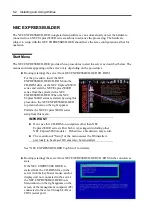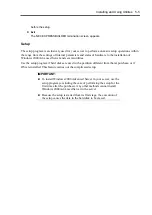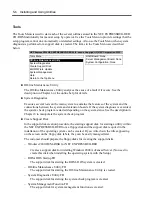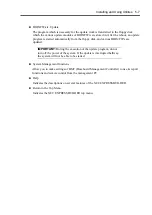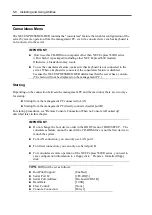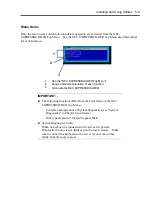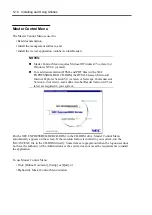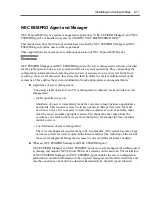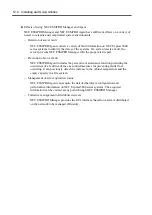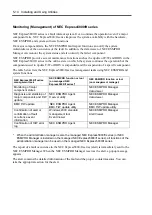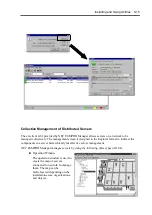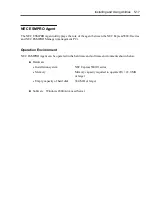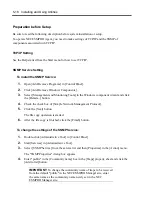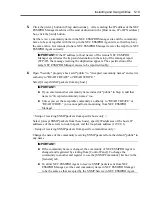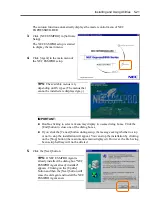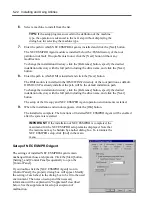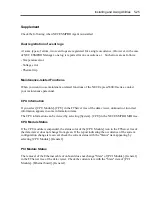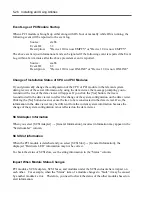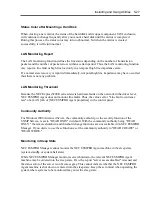
Installing and Using Utilities 5-13
Detection of Server Fault
NEC ESMPRO Manager and NEC ESMPRO Agent detect errors causing faults to occur at an early
stage and notify Administrators of fault information real-time.
Early detection of error
If a fault occurs, NEC ESMPRO Agent detects the fault and reports the occurrence of the
fault to NEC ESMPRO Manager (alert report). NEC ESMPRO Manager displays the
received alert in the alert viewer and also changes the status colors of the server and server
component in which the fault occurs. This allows you to identify the fault at a glance.
Further, checking the content of the fault and the countermeasures, you can take
appropriate action for the fault as soon as possible.
Types of reported faults
The table below lists the typical faults reported by NEC ESMPRO Agent.
Component Reported
information
CPU
•
CPU load is over the threshold
•
CPU degrading, etc.
Memory
ECC 1-bit error detection, etc.
Power supply
•
Voltage lowering
•
Power failure, etc.
Temperature
Temperature increase in cabinet, etc.
Fan
Fan failure (decrease in the number of revolutions), etc.
Storage
File system usage rate, etc.
LAN
•
Line fault threshold over
•
Send retry or send abort threshold over, etc.
Prevention of Server Fault
NEC ESMPRO Agent includes the preventive maintenance function forecasting the occurrence of a
fault as countermeasures for preventing faults from occurring.
NEC ESMPRO Manager and NEC ESMPRO Agent can set the threshold for each source in the
server. If the value of a source exceeds the threshold, NEC ESMPRO Agent reports the alert to NEC
ESMPRO Manager.
The preventive maintenance function can be set for a variety of monitoring items including cabinet
temperature, and CPU usage rate.
Management of Server Operation Status
NEC ESMPRO Agent manages and monitors a variety of components installed in the server. You
can view the information managed and monitored by NEC ESMPRO Agent on the data viewer of
NEC ESMPRO Manager.
NEC ESMPRO Agent also manages and monitors all the components and conditions required to
keep the server reliability at a high level such as hard disks, CPU, memory, fans, power supply, and
temperature.
Summary of Contents for Express5800/320Lb FT Linux
Page 10: ...iv This page is intentionally left blank ...
Page 16: ...x This page is intentionally left blank ...
Page 19: ...Precautions for Use 1 3 Label A Label B Label C Label E Label D ...
Page 20: ...1 4 Precautions for Use Rack mount model Label B Label A Label C Label D ...
Page 21: ...Precautions for Use 1 5 Label D Label C Label B Label A ...
Page 22: ...1 6 Precautions for Use PCI CPU Modules PCI Module CPU Module Label A Label A Label A ...
Page 36: ...1 20 Precautions for Use This page is intentionally left blank ...
Page 44: ...2 8 General Description Front View inside Tower model Rack mount model ...
Page 70: ...2 34 General Description This page is intentionally left blank ...
Page 118: ...3 48 Setup This page is intentionally left blank ...
Page 162: ...4 44 System Configuration This page is intentionally left blank ...
Page 294: ...6 14 Maintenance This page is intentionally left blank ...
Page 336: ...7 42 Troubleshooting This page is intentionally left blank ...
Page 355: ...System Upgrade 8 19 15 Check the disk you selected and click Next 16 Click Complete ...
Page 399: ...System Upgrade 8 63 Cable ties included with cabinet ...
Page 410: ...8 74 System Upgrade This page is intentionally left blank ...
Page 412: ...A 2 Specifications This page is intentionally left blank ...




